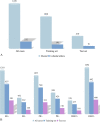Application of preoperative ultrasound features combined with clinical factors in predicting HER2-positive subtype (non-luminal) breast cancer
- PMID: 34856951
- PMCID: PMC8641182
- DOI: 10.1186/s12880-021-00714-0
Application of preoperative ultrasound features combined with clinical factors in predicting HER2-positive subtype (non-luminal) breast cancer
Abstract
Background: Human epidermal growth factor receptor2+ subtype breast cancer has a high degree of malignancy and a poor prognosis. The aim of this study is to develop a prediction model for the human epidermal growth factor receptor2+ subtype (non-luminal) of breast cancer based on the clinical and ultrasound features related with estrogen receptor, progesterone receptor, and human epidermal growth factor receptor2.
Methods: We collected clinical data and reviewed preoperative ultrasound images of enrolled breast cancers from September 2017 to August 2020. We divided the data into in three groups as follows. Group I: estrogen receptor ± , Group II: progesterone receptor ± and Group III: human epidermal growth factor receptor2 ± . Univariate and multivariate logistic regression analyses were used to analyze the clinical and ultrasound features related with biomarkers among these groups. A model to predict human epidermal growth factor receptor2+ subtype was then developed based on the results of multivariate regression analyses, and the efficacy was evaluated using the area under receiver operating characteristic curve, accuracy, sensitivity, specificity.
Results: The human epidermal growth factor receptor2+ subtype accounted for 138 cases (11.8%) in the training set and 51 cases (10.1%) in the test set. In the multivariate regression analysis, age ≤ 50 years was an independent predictor of progesterone receptor + (p = 0.007), and posterior enhancement was a negative predictor of progesterone receptor + (p = 0.013) in Group II; palpable axillary lymph node, round, irregular shape and calcifications were independent predictors of the positivity for human epidermal growth factor receptor-2 in Group III (p = 0.001, p = 0.007, p = 0.010, p < 0.001, respectively). In Group I, shape was the only factor related to estrogen receptor status in the univariate analysis (p < 0.05). The area under receiver operating characteristic curve, accuracy, sensitivity, specificity of the model to predict human epidermal growth factor receptor2+ subtype breast cancer was 0.697, 60.14%, 72.46%, 58.49% and 0.725, 72.06%, 64.71%, 72.89% in the training and test sets, respectively.
Conclusions: Our study established a model to predict the human epidermal growth factor receptor2-positive subtype with moderate performance. And the results demonstrated that clinical and ultrasound features were significantly associated with biomarkers.
Keywords: Breast cancer; Estrogen receptor; Human epidermal growth factor receptor-2; Progesterone receptor; Ultrasound.
© 2021. The Author(s).
Conflict of interest statement
The authors declare that they have no competing interests.
Figures



Similar articles
-
Prognostic values of negative estrogen or progesterone receptor expression in patients with luminal B HER2-negative breast cancer.World J Surg Oncol. 2016 Sep 13;14(1):244. doi: 10.1186/s12957-016-0999-x. World J Surg Oncol. 2016. PMID: 27619909 Free PMC article.
-
Treatment and prognosis of breast cancer patients with brain metastases according to intrinsic subtype.Jpn J Clin Oncol. 2014 Nov;44(11):1025-31. doi: 10.1093/jjco/hyu126. Epub 2014 Aug 25. Jpn J Clin Oncol. 2014. PMID: 25156682
-
Prognostic significance of preoperative 18F-FDG PET/CT for breast cancer subtypes.Breast. 2016 Dec;30:5-12. doi: 10.1016/j.breast.2016.08.003. Epub 2016 Aug 29. Breast. 2016. PMID: 27569020
-
Basal-like immunophenotype markers and prognosis in early breast cancer.Tumori. 2010 Nov-Dec;96(6):966-70. Tumori. 2010. PMID: 21388060
-
Subtype classification for prediction of prognosis of breast cancer from a biomarker panel: correlations and indications.Int J Nanomedicine. 2014 Feb 21;9:1039-48. doi: 10.2147/IJN.S58270. eCollection 2014. Int J Nanomedicine. 2014. PMID: 24591826 Free PMC article.
Cited by
-
A hybrid features fusion-based framework for classification of breast micronodules using ultrasonography.BMC Med Imaging. 2024 Sep 20;24(1):253. doi: 10.1186/s12880-024-01425-y. BMC Med Imaging. 2024. PMID: 39304839 Free PMC article.
-
Value of genomics- and radiomics-based machine learning models in the identification of breast cancer molecular subtypes: a systematic review and meta-analysis.Ann Transl Med. 2022 Dec;10(24):1394. doi: 10.21037/atm-22-5986. Ann Transl Med. 2022. PMID: 36660694 Free PMC article.
References
-
- Goldhirsch A, Winer EP, Coates AS, Gelber RD, Piccart-Gebhart M, Thürlimann B, et al. Personalizing the treatment of women with early breast cancer: highlights of the St Gallen International Expert Consensus on the Primary Therapy of Early Breast Cancer 2013. Ann Oncol. 2013;24(9):2206–2223. doi: 10.1093/annonc/mdt303. - DOI - PMC - PubMed
-
- Bardou VJ, Arpino G, Elledge RM, Osborne CK, Clark GM. Progesterone receptor status significantly improves outcome prediction over estrogen receptor status alone for adjuvant endocrine therapy in two large breast cancer databases. J Clin Oncol. 2003;21(10):1973–1979. doi: 10.1200/JCO.2003.09.099. - DOI - PubMed
Publication types
MeSH terms
Substances
LinkOut - more resources
Full Text Sources
Medical
Research Materials
Miscellaneous

